Model Comparison: Kato and Micro Ace E231 Commuter Trains
06 December 2010 14:14 Filed in: Model Trains,Review
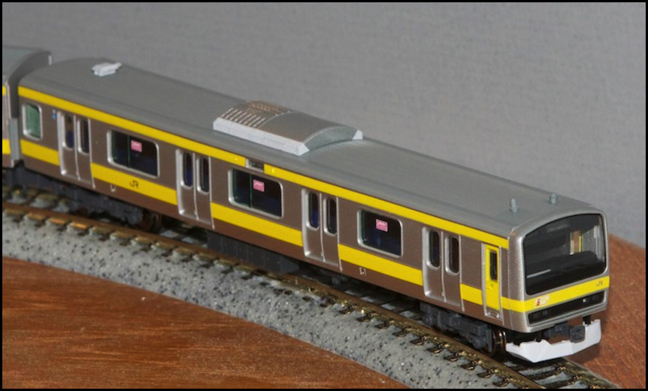
Updated 7 Dec: see note at end about couplers.
The train that got me started in Japanese modeling was the JR East E231, and specifically a Kato model of the Yamanote line version. The E231 is a workhorse of the Tōkyō scene, with over 2,600 cars built since its introduction in 1998, gradually displacing many older commuter and suburban trains to secondary uses or the scrap pile. The train itself is a DC design, typically used in 10-car trains, although the Yamanote line uses 11-car trains and some suburban lines use 10+5 sets that split into 10-car and 5-car trains away from the city. Internal seating is along-the-wall in commuter models, and a mix of that and transverse “booth” seats in suburban ones. In both applications, this is a no-frills train designed to move masses of people efficiently. The Chūō line commuter trains (which use the later E233 variant on Rapids and the Chūō-Sōbu E231 on Locals) carry over 90,000 people per hour at peak hours, in standing-so-close-you-can’t-move crowds.
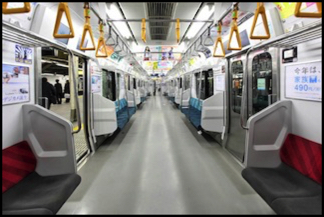
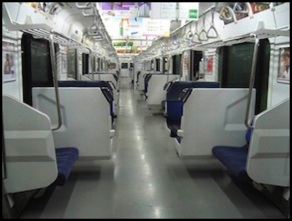
E231 interiors for “commuter” (left) and “suburban” (right) trains
Kato, Tomix and Micro Ace all make models of these, but not all of them model every variant. Kato tends to model the “current” consists in use on major lines, but they have some gaps. One significant one is that Kato has no model of the Sōbu Local (aka., Chūō-Sōbu) E231-0 version. Tomix has modeled many of the standard versions as well as a couple of specialized ones. And Micro Ace has modeled several specialized variants.
For example, all three produce models of the Yamanote line E231-500, which I think is the most numerous with 51 11-car trains (592 cars total), and Jōban line E231-0 (265 cars), but only Micro Ace produces a Sōbu line E231-0 (of which there are 45 trains in service totaling 450 cars). Kato’s selection is the most limited, with only Yamanote, Jōban and a Tōkaidō/Shōnan-Shinjuku version of the outer-suburban model (all of these are usually available however). Tomix is similar, but adds the Sōbu and a second version of the suburban train (Tōhoku/Takasaki). Availability of the Tomix models is generally good, although many previous variants of the suburban train are no longer available.
Micro Ace is thus of interest because of their diversity, but at a cost. Sets to make a 10-car Jōban train cost US$208.34 from Kato, US$243.55 from Tomix and US$265.43 from Micro Ace at the current exchange rate. But Micro Ace makes two different versions of the Sobu train and four versions of the suburban train. Aside from that, how do they stack up?
I can’t compare to Tomix, as I have no Tomix E231 models (or any Tomix EMU models; I’ve avoided Tomix due to reputed difficulties in converting them to DCC, and because they offer no additional models I really care about). And I don’t have the exact same model from both manufacturers, so lets compare Kato’s Jōban line version of the E231-0 to Micro Ace’s Sōbu line version of the E231-0. Specifically I’m using the “strengthened skirt” version of the Sōbu train, which represents a post-2008 variant with a slightly different cab design, and the addition of a six-door car in the train (most E231 cars have four door sets per side).
Kato’s Jōban E231-0
The Kato sets for a 10-car train, 10-551 (basic 6 cars) and 10-552 (add-on 4 cars), are slightly older designs for Kato (introduced in early 2009). In more recent releases they’re using basic sets with four or five cars, and two add-on sets to make a full train. These are still fairly representative of newer Kato designs (they’re using numbers in the 800s and 900s for the newest sets, but those followed the 500 sets). As noted above, these would cost a total of US$243.55 if bought today (at the current poor exchange rate).
Interior lighting can be added using Kato’s LED-based lighting sets (11-209 and 11-210). With one 6-pack and four of the single sets, that comes to US$45.97. The good news is that these are relatively easy to find in the U.S., as they’re also used for some of the Kato North American-prototype passenger cars.
You have to add two antennas on each cab car, as well as window decals including the destination markers (which come with several options, although it’s all in Japanese and too small to read from any ordinary distance anyway). The car has directional head and tail lights, and when not using DCC the set facing another car (in a 10+5 configuration) can be turned off with a switch that comes in the DCC socket.
The motors are fairly quiet and smooth running, and are flywheel equipped. They are reputed to be 5-pole motors as well (and Kato does use and advertise the use of those on North American-prototype models, but they don’t call this detail out on Japanese-prototype models). However, in some recent Kato models I have heard a fair bit of motor “whine”, so this is variable between models. (Edit: the motors are 3-pole, as are Micro Ace’s, see my later musing on this).
One advantage of Kato’s model is that it is “DCC Friendly”. This doesn’t mean that there’s an NEM or NMRA socket, but that Kato has provided slide-in receptacles for their specially-commissioned motor and cab-car decoders (made by Digitrax under the Kato name). Unfortunately, installing these is rarely an effortless process as the decoders often make poor contact with the electrical pads they slide against (see my Adding DCC and Lights page), and I’d be much happier if they’d used a real socket. That said, this one went relatively smoothly (I’ve had problems with others). Adding these for the Cab and Motor cars (ignoring interior lighting DCC decoders, as Kato says the lights will work fine on DCC without a decoder) would cost US$51.97 if you can get these from a domestic supplier.
The wheels are blackened metal. The flanges are fairly broad (typical of Japanese models), but so dark that you really don’t see them at all.
Kato additionally makes their models with prototypical Scharfenberg couplers (edit 24 July 2011: technically it’s a Shibata coupler, see Japanese wikipedia), which plug together fairly easily (you need good eyesight to align them, and taking them apart is harder and requires lifting the cars off the track; they’re really not good for prototypical 10+5 operation if you want to split the train in two).
Bottom line cost with DCC and Lighting: US$341.49. Which sounds like a lot, but remember that it’s for a ten-car train, and at $34 per car, it’s not much more than you’d pay for a lighted Acela car from Bachman (which doesn’t include DCC) at $25.
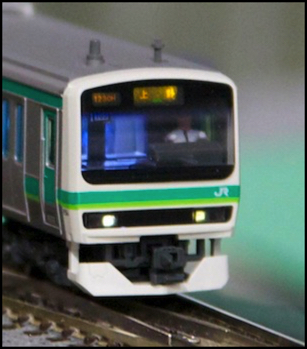
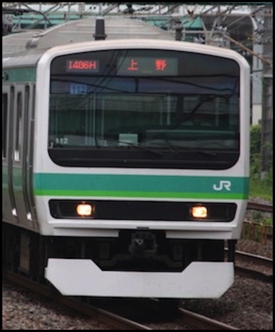
Kato Cab (after figure and lighting added), as compared with prototype
Kato has a very high standard of detail for the most part, with a few exceptions. The skirt is attached to the cab body with a white bracket, where the prototype’s is black, but otherwise the color and shape of the cab has been well-captured. The rooftop antennas are separately applied, and sit vertically, although the one on the left doesn’t seem to be quite the right shape to match the prototype.
Micro Ace’s Sōbu E231-0
The Micro Ace sets for a 10-car Sōbu train, A4012 (basic 6 cars) and A4013 (add-on 4 cars) were released in 2010, and thus represent the current state of Micro Ace’s models. These cost US$285.40 today (why this one costs more than the Jōban train is unclear, perhaps they raised the cost in Yen on newer models to reflect the economy; the Micro Ace Jōban is an older model).
I’ve had variable luck with the Micro Ace motors. Mostly they don’t seem to run as smoothly or as quietly as the Kato models (but there have been exceptions). In the best, the slow-speed operation is nearly as good as Kato’s is, but not quite the same. And they can be even quieter than Kato’s, but not always. And there’s a lot more variability from one train to the next. In this particular model the motor was quite loud out of the box, but that’s common for a not-yet-run-in train. Unfortunately, while running it in the train hit an obstacle that had fallen across the track unnoticed, and was stalled for a considerable time. It’s now quite loud and has poor low-speed operation, but that may well be my fault. I need to take it apart, do some cleaning and lubricating, and see if I can get it to work better, but that’s a project for another day.
Micro Ace sells their train with Rapido couplers (which look huge next to these small cars), however there is a dummy Scharfenburg on the ends of the cab cars, and you can replace the Rapidos with Micro Ace’s gray Scharfenberg couplers (set F0002) if you can find them, unfortunately they’re often sold out (
Wheels are blackened metal, although not quite as dark as Kato’s, primarily because the flange doesn’t seem to have been darkened (see side-on photos below).
Bottom line, with lighting this goes for US$390.48. Added to that would be three decoders to convert it to DCC (US$59.97 using three of Digitrax’s DZ125 decoders, which are functionally equivalent to the Kato models, although you could likely reduce this a bit with others). That brings the total to $461.87, or US$120.38 (35%) more than the Kato model. Are you getting a third more value? We’ll see.
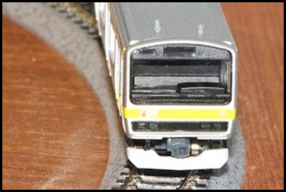
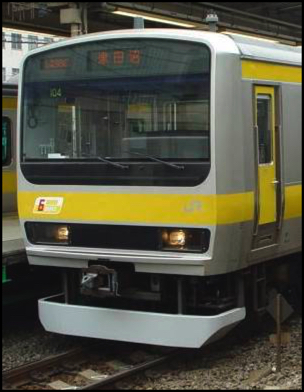
Micro Ace Cab (without added detail) as compared with prototype
The exterior detail for Micro Ace is quite good, and like Kato mostly molded on. The window decals come pre-applied, but you still need to apply destinations (and like Kato you have a number of choices).
The cab correctly reproduces the skirt shape (including the dark bracket), with a dummy Scharfenberg coupler. The rooftop antennas come pre-installed, and don’t look quite as good as Kato’s; the left one lacks a flat mounting point, so it’s actually angled slightly to one side instead of being vertical, but they’re still done to a high standard.
Detail Comparison
Now to see how the level of detail between the cars themselves compares.

Kato: Interior molding with beige plastic seats (before and after painting floor gray; white bracket is lighting)
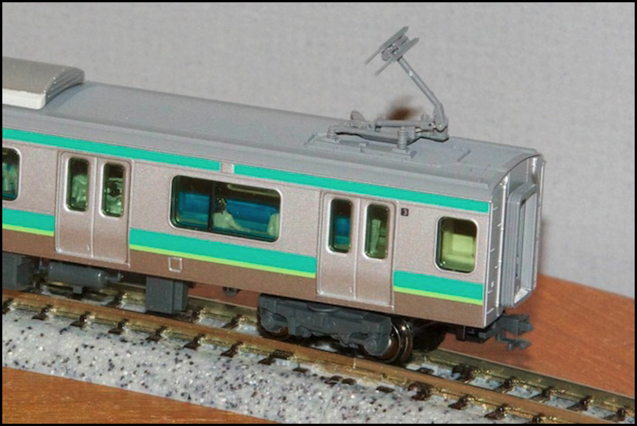
Kato showing interior seats (painted by me), pantograph and end-of-car detail
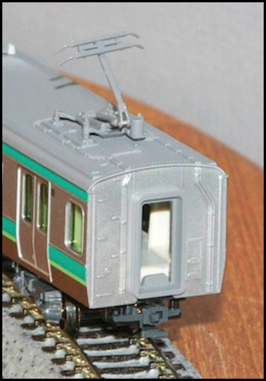
Kato end-of-car detail
Kato’s interiors have molded seating, but it’s all one color (beige) in a single plastic molding and doesn’t separate the individual seats. The light color also looks too bright under interior lighting. In the motor car, the bench detail is less pronounced and the interior is mostly a flat panel, but there are the tops of seat-backs that protrude above the window line, which are helpful when adding figures (cut-off at the waist, and leaned against the bench tops).
The exterior detail on the pantograph and the end of the car is a bit understated, but the diaphragm is a separate plastic molding in a different color, and sticks out further than the one on the Micro Ace model.
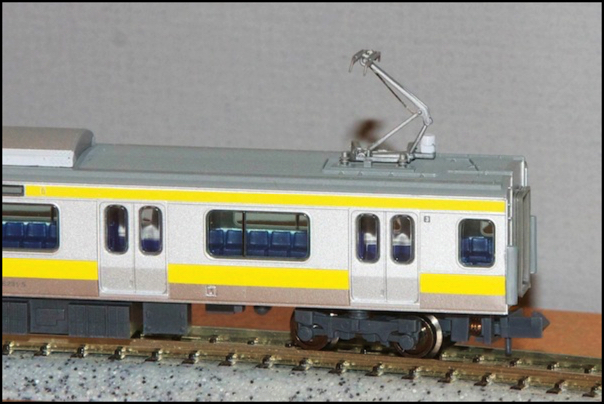
Micro Ace: Close-up showing interior molding of seats, pantograph and end-of-car detail
Although the under-car detail looks good in the photo above, it appears to be less detailed than the Kato models on most cars. This is nearly impossible to see without picking up the cars.
Micro Ace also has molded interior detail, but it’s done in a dark color and with individual seat details. In the motor car there is no detail, just a flat surface of the same dark color immediately below the window line.
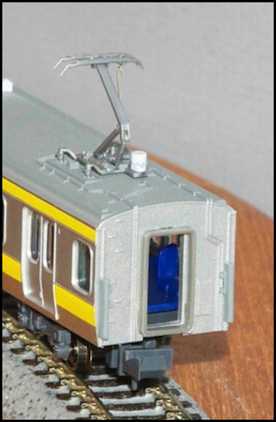
Micro Ace: end-of-car detail
The pantograph detail is quite nice, although the end-of-car detail is similar to Kato’s. In fact, the diaphragm, although a separate molding, doesn’t look as good. However, the bumpers on the sides of the ends are reproduced, something Kato models lack. These do not come anywhere near touching the adjacent car, however, so they are not very realistic in that sense.
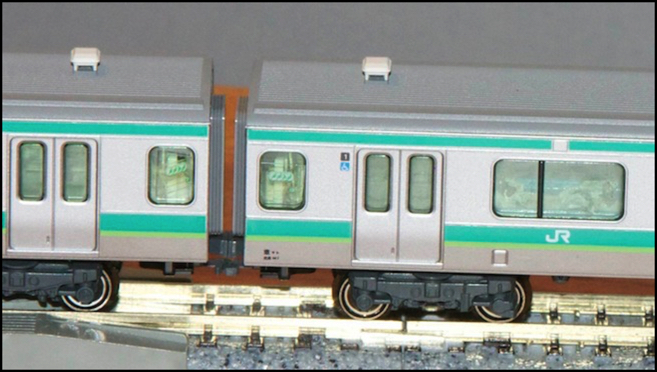
Side view showing diaphragms between cars, lettering below windows and by doors, and blackened wheels
Note the square above the window interrupting the top stripe. This is a detail found on the Yamanote line cars which appears to also exist on the real Jōban ones (I can’t find a good side-on photo of a Jōban car, just an oblique one that might show it). The square is lacking on the Micro Ace model, but this is correct for the Sōbu line version of the E231-0. Also, the rubber bumpers on the edges of the car ends are lacking here, as mentioned above. Finally, the square below the right-most window is blank, while on the prototype there is a hole in it (as shown on the Micro Ace model below).
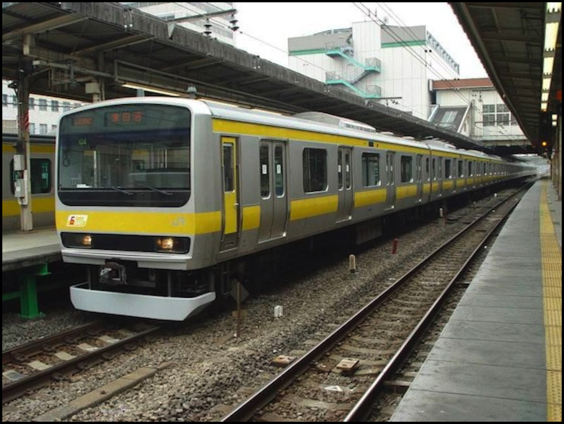
Prototype side view
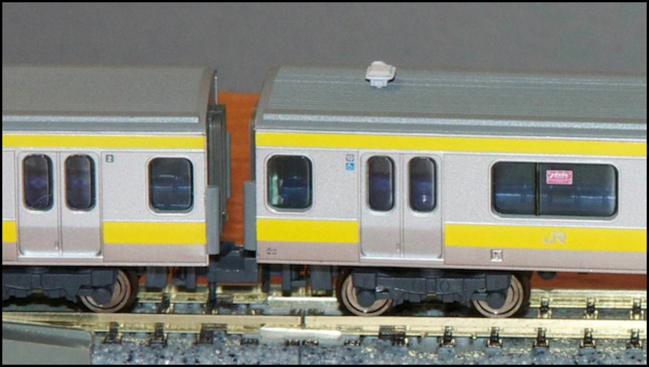
Side view showing diaphragms between cars, lettering below windows and by doors, and blackened wheels
The lettering (lower left corner or rightmost car) wasn’t as good as the Kato model although the number and wheelchair symbol next to the door was nicely done. With the Rapidos the separation was larger, but the detail was otherwise equal or better.
Summary
In the end, I think Micro Ace did a superior job on the detail of the model. That said, Kato’s is still quite detailed and Micro Ace wasn’t without issues, and much of this can’t be seen from a normal viewing distance.
Mechanically, the Kato is superior, both on this specific model and on my average of recent models. Out of the box it has closer coupling and slightly longer diaphragms which make it seem even closer. And the motor runs like a fine watch. DCC installation was relatively easy (on this model; not something you can say about every E231 they make). The interior lighting is too bright with the light-color interior, but a bit of paint solved that problem for me.
They’re both fine models when you come right down to it. I’m going to continue buying Kato where I can, but if Micro Ace can fill in a gap, as it did with this Sobu model, I’ll only wince slightly when paying the extra hundred dollars.
And if you’re interested, one advantage that Kato has is that you can sometimes find them from domestic dealers, although they’re less common than Shinkansen models from Kato. MB Klein has one E233-1000 Keihin-Tohoku 6-car train in stock as I type this, and it’s been there for six months so they’re clearly not as popular as the bullet train or tram models.
Update: fixed an error in the number of couplers needed for a 10-car train (three packs of six, not two, someday I need to learn to add). Also, as noted by Don in the comments, the Tomix body-mount couplers can be used if desired. These are being re-issued as part 0337, and three sets of these will cost US$42.81, which is slightly more expensive than the US$34.26 of the Micro Ace couplers, but these are reported to couple closer and look better. Edit: 24 July 2011: as noted above, the E231 (and many other Japanese EMUs) uses the Shibata coupler, which has a pyramidal appearance, as opposed to a true Scharfenburg, which has a conical appearance. However the term “Scharfenberg” is often used as a collective term for all close-couplers of this style.
Note: prototype photos are from wikimedia commons. Click on photo to link to original with creator attribution.
Other website changes:
- I’ve updated the Roster and Subway/Trams pages to show my latest acquisition, yet another Setagaya tram (this one in “cherry red”, which looks more like pink in these photos, but is darker in real life).
- I’ve updated my Freight Cars page (still a work in progress).
- I updated both the Phase 2j and Station Photos pages with a panoramic photo of the still-being-planned Riverside Station track mock-up (nothing much has really happened there this week).
== Comments copied from old system:
Monday, December 6, 2010 - 08:43 AM
Don
A nice comparison, and useful too. Thank you! The MA's interior is considerably better than I'd expected! But notice that you don't have to fit MA's couplers to MA models: They will take Tomix body-mount TN couplers too, which in my opinion and others look considerably better.
http://akihabara.artificial-science.org/2009/12/14/tomix-tn-couplers/
Sunday, April 3, 2011 - 06:52 PM
Anonymous
Or you could buy Kato's 11-706 grey Scharfenbergs from Rainbow Ten at Y320 for 10 couplings which fit any Rapido sockets :)
Angus McLean




